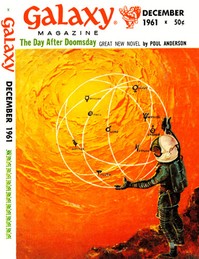The Little Man Who Wasn't Quite by William W. Stuart
"The Little Man Who Wasn't Quite" by William W. Stuart is a short story that falls within the speculative fiction genre. Written in the early 1960s, the narrative explores themes of perception, existence, and the human condition through a unique lens of reality and surrealism. The story revolves around the lives of the marginal figures often found on skid row, delving into the experiences of those who exist on the fringes of
society, particularly through the lens of a character named Wino Jones and his elusive friend, Stanley. The plot unfolds as the narrator encounters Wino Jones, a seemingly amiable man who introduces him to Stanley, a small, shadowy figure that only some can see. As the story progresses, it becomes evident that Stanley embodies the forgotten and ignored individuals of the world, existing in a state of near-invisibility while desperately seeking recognition and connection. Wino Jones shares his deep friendship with Stanley, who begins to exhibit more pronounced characteristics and ambitions to escape the confines of their life on skid row. However, when Stanley invites Bootnose, another street dweller, to join him on a journey beyond the normal realm, a dark presence, representing the collective fears and ghosts of skid row, is unleashed. The story culminates in an unsettling abandonment of the known world, leaving the reader to ponder the consequences of disregard and loss in a society that often overlooks its most vulnerable individuals. (This is an automatically generated summary.)
Read or download for free
| How to read | Url | Size | |||
|---|---|---|---|---|---|
| Read now! | https://www.gutenberg.org/ebooks/51698.html.images | 62 kB | |||
| EPUB3 (E-readers incl. Send-to-Kindle) | https://www.gutenberg.org/ebooks/51698.epub3.images | 245 kB | |||
| EPUB (older E-readers) | https://www.gutenberg.org/ebooks/51698.epub.images | 244 kB | |||
| EPUB (no images, older E-readers) | https://www.gutenberg.org/ebooks/51698.epub.noimages | 80 kB | |||
| Kindle | https://www.gutenberg.org/ebooks/51698.kf8.images | 280 kB | |||
| older Kindles | https://www.gutenberg.org/ebooks/51698.kindle.images | 273 kB | |||
| Plain Text UTF-8 | https://www.gutenberg.org/ebooks/51698.txt.utf-8 | 55 kB | |||
| Download HTML (zip) | https://www.gutenberg.org/cache/epub/51698/pg51698-h.zip | 222 kB | |||
| There may be more files related to this item. | |||||
Similar Books
About this eBook
| Author | Stuart, William W. |
|---|---|
| Illustrator | Walker |
| Title | The Little Man Who Wasn't Quite |
| Series Title | Produced from Galaxy Magazine December 1961 |
| Note | Reading ease score: 94.0 (5th grade). Very easy to read. |
| Credits |
Produced by Greg Weeks, Mary Meehan and the Online Distributed Proofreading Team at http://www.pgdp.net |
| Language | English |
| LoC Class | PS: Language and Literatures: American and Canadian literature |
| Subject | Science fiction |
| Subject | Short stories |
| Subject | Skid row -- Fiction |
| Category | Text |
| EBook-No. | 51698 |
| Release Date | Apr 8, 2016 |
| Copyright Status | Public domain in the USA. |
| Downloads | 109 downloads in the last 30 days. |
| Project Gutenberg eBooks are always free! | |

